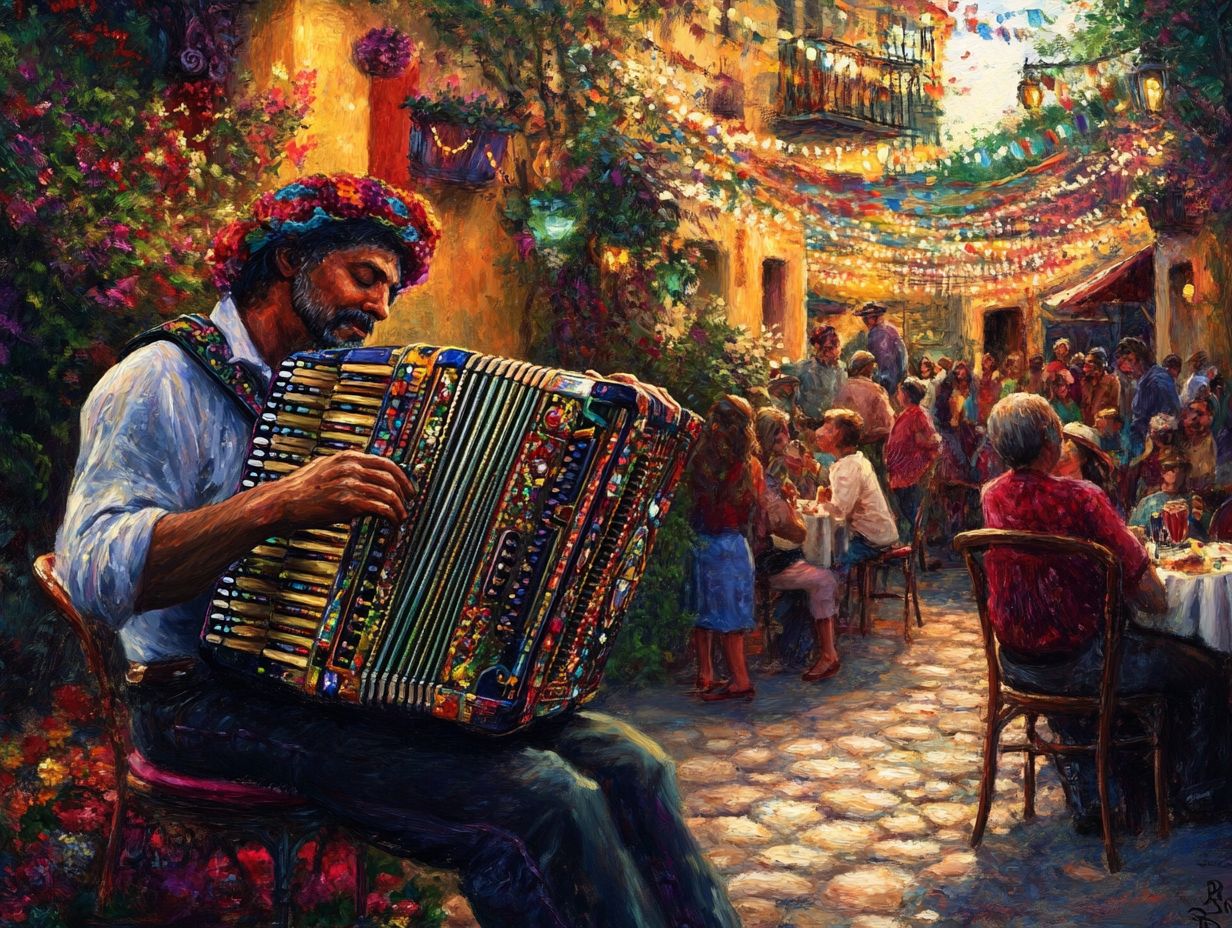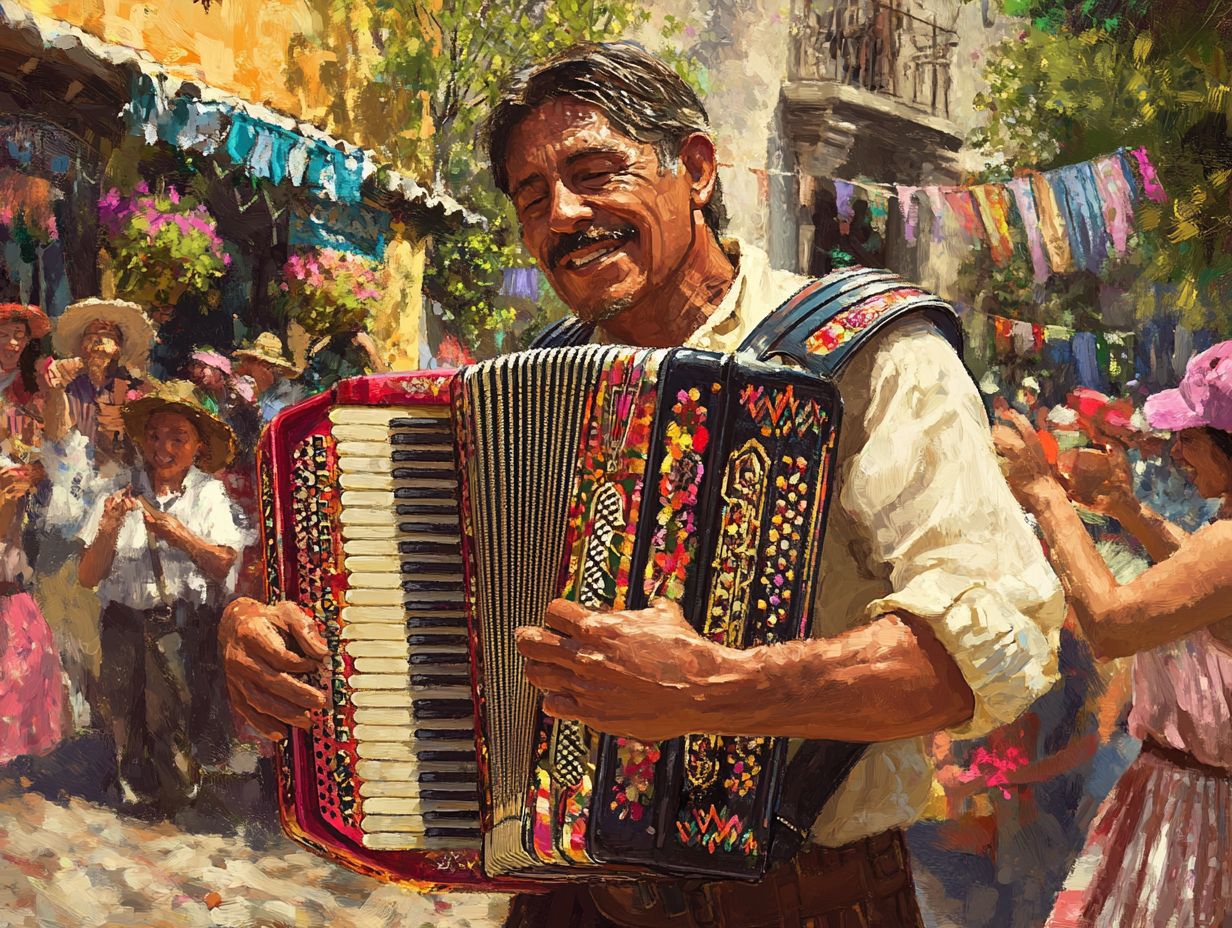The accordion is a versatile and captivating instrument with a rich history that spans cultures and continents. From its origins to its evolution, the accordion has played a vital role in folk music genres worldwide, infusing vibrant melodies into various traditions.
This piece explores the journey of the accordion, highlighting its cultural significance, renowned players, and the intricate craftsmanship that contributes to its unique sound.
Whether you are a seasoned musician or a curious beginner, you will discover the innovations that are shaping accordion music today.
Contents
The History of the Accordion

The accordion is a versatile musical instrument celebrated for its distinctive acoustic sound. Its history, craftsmanship, and cultural significance span centuries and continents. Originating in Europe, the accordion has evolved to become a key component of various music genres around the world.
The craftsmanship of the accordion reflects the cultural heritage of different regions, showcasing the artistry and innovation of its makers. Additionally, the accordion holds an important place in folk traditions and plays a significant role in the global music landscape, influencing numerous musical genres and styles.
Origins and Evolution
The accordion originated in early 19th-century Europe as a simple instrument that utilized bellows and reeds to produce sound. It quickly became a cherished part of folk traditions around the world, evolving rapidly from its humble beginnings.
As the accordion spread across Europe, its design became more sophisticated, leading to regional adaptations that suited local musical styles. In France, the accordion played a crucial role in the development of musette, a lively dance music, while in Italy, it was an essential feature of traditional folk music, particularly in the polka and tarantella styles.
Over the decades, the accordion has been embraced by various musical genres, from the vibrant rhythms of Cajun and Zydeco in Louisiana to the rich emotional sounds of Argentinian tango, showcasing its influence and versatility across a wide array of musical landscapes.
The Accordion in Folk Music
The accordion has become an integral part of folk music worldwide, serving as a vital instrument for musical storytelling and artistic expression. It is deeply embedded in community gatherings and local traditions, playing a significant role in the folk music revival that is being observed in many cultures today.
Popular Folk Genres and Accordion Use

The accordion is a vital instrument in a variety of folk genres, including Cajun, Zydeco, Polka, and Irish folk music, enhancing their unique regional sounds in both live performances and recordings.
For instance, Cajun folk music relies heavily on the accordion as a primary instrument, characterized by its upbeat, danceable rhythms. Notable accordionists like Marc Savoy, the son of a Cajun accordion builder, played a significant role in reviving Cajun music during the 1970s and 1980s.
Similarly, the accordion contributes to the vibrant sound of Polka music, as showcased by accordionist Frank Stasiewicz in his recordings of traditional polkas. In Irish folk music, the accordion has become a staple instrument, featuring prominently in many performances and commercial recordings within the genre.
The Global Spread of the Accordion
The global spread of the accordion has been driven by cultural exchange and migration, enabling this versatile instrument to adapt to a wide range of musical styles and regional instruments. As a result, it has enriched the folk music traditions of many vibrant cultures around the world.
Influence on Different Cultures and Regions
The accordion has significantly influenced cultures throughout its history, seamlessly integrating into local musical styles and becoming a key component of folk music revivals across Europe, as well as North and South America.
It has played an essential role in traditional Eastern European folk dances that celebrate regional heritage, often accompanied by lively performances. In Latin American genres such as cumbia and norteño, the accordion’s rich tones evoke a sense of community and festivity.
Its adaptability has made the instrument a cherished element of Cajun, jazz, and even contemporary pop music in North America, bridging diverse musical traditions and fostering cross-cultural collaboration.
As the accordion continues to evolve, it resonates with new generations, underscoring its enduring relevance in contemporary music scenes.
Famous Accordion Players

Renowned accordion players are musicians who have attained legendary status due to their mastery of the instrument and their significant contributions to musical artistry and storytelling. These artists have demonstrated the versatility of the accordion across various genres, including folk music and performance art.
Notable Performers and Their Contributions
Notable accordion players like Astor Piazzolla and Myron Floren have transcended traditional boundaries by incorporating innovative techniques and styles that have reshaped the perception and use of the accordion in both folk music and performance art. Piazzolla’s fusion of Argentine tango with classical music propelled the instrument into new realms, infusing his compositions with complexity and emotional depth.
In contrast, Floren’s approach popularized the accordion in American entertainment, showcasing its versatility across genres from polka to country. Each of these musicians, along with others, has not only elevated the accordion to new heights but also demonstrated its capacity for expression and storytelling, making it an integral part of the musical landscape.
Their distinctive techniques—whether through Piazzolla’s jazzy inflections or Floren’s spirited rhythms—highlight the accordion’s adaptability and ongoing evolution within the global music scene.
Accordion Construction and Sound
The accordion is made up of various components that are meticulously crafted and assembled, contributing to the instrument’s distinctive sound. This unique construction makes the accordion an intriguing musical instrument to both play and listen to.
Components and How They Affect the Music

The accordion consists of several key components, including the bellows, reeds, and keyboard, each of which contributes to the rich harmonies and diverse range of sounds that make it a versatile musical instrument.
The bellows function like lungs, enabling players to control airflow and dynamics by drawing in and pushing out air, which causes the reeds to vibrate and produce sound.
Typically made from metal or cane, the reeds are tuned to generate specific pitches, allowing musicians to create a wide array of tones.
The keyboard, whether piano-style or button-based, serves as the interface for melody and harmony, facilitating intuitive play.
Recent advancements in accordion design, such as electronic amplification and customizable reed configurations, have further enhanced its capabilities, making it a popular choice across various genres, from folk to contemporary music.
Learning to Play the Accordion
Due to the rapid advancements in technology, musicians will have access to a broader range of accordion learning options. These include virtual reality (VR) lessons, 3D holographic tutors, and increasingly sophisticated accordion learning apps.
Such innovations will enhance the efficiency and effectiveness of learning to play the accordion.
Resources and Techniques for Beginners
Beginners learning the accordion have access to a variety of resources, including instructional books, online courses, and community workshops that offer essential learning techniques and foster connections within the folk music community. These tools not only serve as foundational materials but also allow students to practice at their own pace while receiving guidance from experienced players.
Joining local folk music groups or online forums can significantly enhance the learning experience by facilitating collaboration and feedback. Additionally, websites like YouTube provide numerous tutorials for every skill level, making it easy to find specific techniques or styles to explore.
Engaging with fellow enthusiasts at jam sessions or open mic nights can further boost motivation, creating a supportive atmosphere for showcasing progress and experimenting with new musical directions.
Modern Innovations in Accordion Music
Recent innovations in accordion music have given rise to new styles and artistic collaborations, expanding the horizons of this traditional instrument and integrating it into contemporary music scenes across various genres.
New Styles and Collaborations
Accordion music today is being transformed by new styles that emerge from artistic collaborations, blending various musical genres and reflecting cultural diversity in performances worldwide. The instrument’s versatility is highlighted in projects that combine traditional folk music with modern genres such as jazz, electronic, and world music.
Collaborations between renowned accordionists and artists from diverse backgrounds—ranging from flamenco guitarists to hip-hop beatmakers—create innovative sounds that not only attract new audiences but also preserve the rich histories of their respective traditions.
These artistic partnerships extend the reach of accordion music, establishing it as an integral part of the global music scene that transcends borders. Furthermore, initiatives that promote accordion music in unique contexts, such as urban festivals or online platforms, enhance cultural exchange and appreciation, securing the accordion’s place in today’s diverse musical landscape.
